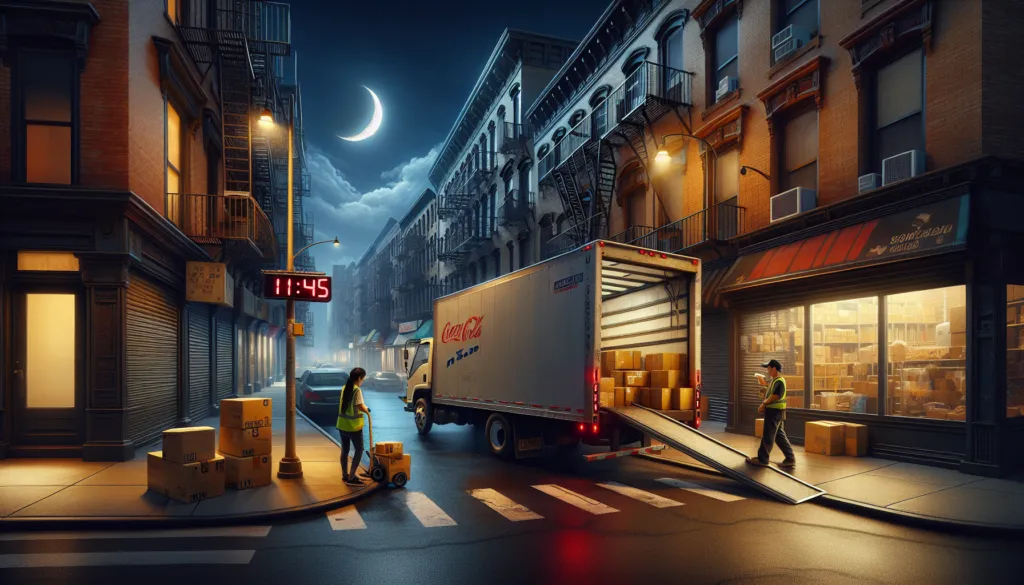
Get home early with RoadWarrior.
Enter your stops, optimize your routes, manage your team – quickly and efficiently.
Try RoadWarrior free for 7 days
Try free for 7 daysThe world of logistics never sleeps, but when do delivery trucks stop delivering? This question intrigues many, especially those awaiting important packages or businesses managing their supply chains. Understanding delivery schedules is crucial in our fast-paced society, where timely shipments can make or break operations. From major carriers like UPS and USPS to local delivery services, the patterns of night deliveries have a significant impact on how goods move across cities and countries.
This article delves into the intricacies of night delivery hours and the factors that shape them. It explores the legal and regulatory aspects that govern when trucks can operate, shedding light on why some areas might experience deliveries later than others. The piece also examines how cutting-edge technology is changing the game, allowing for more efficient and extended delivery windows. By the end, readers will gain valuable insights into the complex world of nocturnal logistics and its effect on our daily lives.
Understanding Truck Delivery Schedules
Truck delivery schedules play a crucial role in the logistics industry, determining when goods reach their destinations. These schedules are influenced by various factors, including the time of day, peak delivery periods, and specific industry requirements. Understanding these patterns is essential for both shippers and receivers to optimize their operations and ensure timely deliveries.
Day vs. night delivery patterns
The trucking industry operates 24/7, 365 days a year, with delivery patterns varying significantly between day and night. During daytime hours, typically from 6 AM to 6 PM, traffic congestion and business hours of most receivers can impact delivery efficiency. Many shippers and receivers prefer daytime deliveries due to staff availability and ease of operations.
Night deliveries, occurring between 7 PM and 6 AM, offer unique advantages. With reduced traffic, trucks can often complete deliveries more quickly. For instance, in a pilot project in New York City, trips made during off-peak hours took half the time of those made during peak hours. This efficiency can lead to cost savings for carriers and potentially lower prices for customers.
However, night deliveries come with their own set of challenges. Noise concerns in residential areas and the need for staff to receive goods during off-hours can be problematic. Additionally, some drivers prefer to maintain a consistent sleep schedule, making night deliveries less appealing.
Peak delivery times
Peak delivery times vary depending on the industry and location. Generally, the busiest periods for deliveries occur during business hours, with many companies scheduling deliveries between 10 AM and 2 PM. This timeframe allows for morning preparations and afternoon processing of received goods.
For the trucking industry, September, October, and November are typically the busiest months, while January, February, and March are generally slower. December can be variable, depending on the economy and holiday shopping patterns. These seasonal fluctuations have a significant impact on when do delivery trucks stop delivering, as carriers adjust their schedules to meet demand.
Certain industries have specific peak times. For example, food service deliveries often occur in the early morning hours to ensure fresh products are available for the day’s operations. Retail deliveries might peak in the afternoon to avoid disrupting customer shopping experiences.
Factors influencing delivery schedules
Several key factors have an impact on delivery schedules:
- Hours of Service (HOS) regulations: These rules limit the number of hours drivers can work, affecting when deliveries can be made. For instance, drivers are restricted to 11 hours of driving within a 14-hour on-duty period, followed by a 10-hour break.
- Traffic patterns: Urban areas experience heavy traffic during morning and evening rush hours, influencing when carriers choose to make deliveries. Many opt for off-peak hours to avoid congestion.
- Customer requirements: Some businesses have specific time windows for accepting deliveries, which carriers must accommodate in their schedules.
- Length of haul: The distance a shipment needs to travel significantly impacts delivery timing. Shipments traveling 400-500 miles often suit morning pickups, while those exceeding 500 miles may require afternoon or evening schedules.
- Weather conditions: Adverse weather can cause delays and impact when do delivery trucks stop delivering, as safety becomes a primary concern.
- Loading/unloading times: The efficiency of these processes at both origin and destination points can affect overall delivery schedules.
Understanding these factors helps both shippers and carriers optimize their operations. For instance, UPS and USPS often adjust their delivery schedules based on these variables to ensure efficient and timely service. By considering these elements, businesses can better plan their logistics and set realistic expectations for when their goods will arrive or when do delivery trucks stop delivering.
Legal and Regulatory Aspects of Night Deliveries
The legal and regulatory landscape governing night deliveries is complex and multifaceted. It involves various entities, from federal agencies to local municipalities, each with its own set of rules and regulations. These regulations have a significant impact on when do delivery trucks stop delivering and how they operate during nighttime hours.
Department of Transportation regulations
The Department of Transportation (DOT) plays a crucial role in regulating the trucking industry. Through its branch, the Federal Motor Carrier Safety Administration (FMCSA), the DOT establishes and enforces rules that govern commercial vehicle operations, including night deliveries. These regulations are designed to ensure road safety and prevent accidents caused by driver fatigue.
One of the most critical aspects of DOT regulations is the Hours of Service (HOS) rules. These rules limit the number of hours commercial truck drivers can be behind the wheel without a break. For property-carrying drivers, the regulations stipulate that they cannot drive for more than 11 hours after 10 consecutive hours off duty. Additionally, drivers must take a 30-minute break after driving for 8 cumulative hours.
The HOS regulations also include the 14-hour rule, which states that drivers cannot drive beyond the 14th consecutive hour after coming on duty, following 10 consecutive hours off duty. This rule is particularly relevant for night deliveries, as it determines when drivers must stop delivering, regardless of the time of day.
Local noise ordinances
While federal regulations focus on driver safety and working hours, local noise ordinances have a direct impact on when do delivery trucks stop delivering in residential areas. Many municipalities have specific restrictions on noise levels during nighttime hours to protect residents’ quality of life.
For instance, some cities prohibit deliveries or any loud activities between 10 p.m. and 7 a.m. Others may have more flexible rules, allowing deliveries but with strict noise level limits. These ordinances often specify maximum decibel levels that cannot be exceeded during nighttime hours, typically ranging from 50 to 60 dBA.
Enforcement of these ordinances can vary. Some cities may grant waivers for essential deliveries, while others strictly adhere to their noise regulations. For companies like UPS and USPS, understanding and complying with these local ordinances is crucial to maintain smooth operations while respecting community needs.
Driver hours of service rules
The FMCSA’s Hours of Service rules are a cornerstone of trucking regulations, directly influencing when do delivery trucks stop delivering. These rules are designed to prevent driver fatigue, a significant factor in truck-related accidents.
Key aspects of the HOS rules include:
- 11-Hour Driving Limit: Drivers may drive a maximum of 11 hours after 10 consecutive hours off duty.
- 14-Hour Limit: Drivers may not drive beyond the 14th consecutive hour after coming on duty, following 10 hours off duty.
- Rest Breaks: Drivers must take a 30-minute break when they have driven for a period of 8 cumulative hours without at least a 30-minute interruption.
- 60/70-Hour Limit: Drivers may not drive after 60/70 hours on duty in 7/8 consecutive days.
These rules apply to both daytime and nighttime deliveries, ensuring that drivers have adequate rest periods regardless of their shift times. For companies operating around the clock, like UPS and USPS, these regulations necessitate careful scheduling and driver rotation to maintain continuous service while complying with HOS rules.
Technology Enabling Night Deliveries
Advancements in technology have revolutionized the logistics industry, enabling more efficient and secure night deliveries. These innovations have a significant impact on when do delivery trucks stop delivering, allowing for extended operational hours and improved service quality. Companies like UPS and USPS have embraced these technologies to enhance their delivery capabilities during nighttime hours.
GPS tracking systems
GPS tracking systems have become an integral part of modern logistics operations, particularly for night deliveries. These systems provide real-time location data, allowing companies to monitor their fleet’s movements with precision. For instance, some advanced GPS trackers offer features such as route history, dispatch management, and incident reporting, which are crucial for optimizing nighttime delivery schedules.
The implementation of GPS technology has enabled companies to track their vehicles 24/7, ensuring that delivery trucks can operate efficiently even during late hours. This constant monitoring has a direct impact on when do delivery trucks stop delivering, as it allows for better route planning and more accurate delivery time estimates. UPS and USPS utilize sophisticated GPS systems to manage their extensive fleets, ensuring timely deliveries regardless of the hour.
Moreover, GPS tracking systems contribute to driver safety during night deliveries. They provide alerts for unsafe driving practices and unauthorized vehicle use, allowing companies to take prompt corrective action. This enhanced safety measure enables delivery trucks to operate for extended hours without compromising on security.
Automated sorting facilities
Automated sorting facilities have transformed the way packages are processed, significantly extending the operational hours of delivery services. These high-tech facilities use advanced machinery and software to sort packages quickly and accurately, reducing the need for manual intervention.
For example, UPS’s Worldport facility in Louisville, Kentucky, is a prime example of how automated sorting systems can revolutionize night deliveries. This facility processes nearly 5 million packages in a single day, with an average of 1.8 million packages sorted daily. The automated systems at Worldport are 99.99% accurate, allowing UPS to handle a massive volume of packages efficiently, even during nighttime hours.
These automated facilities have a substantial impact on when do delivery trucks stop delivering. By streamlining the sorting process, trucks can be loaded more quickly and efficiently, allowing for later departure times and extended delivery windows. This efficiency enables companies like UPS and USPS to offer overnight and early morning delivery options, pushing the boundaries of traditional delivery schedules.
Smart lockers and secure drop-off points
Smart lockers and secure drop-off points have emerged as innovative solutions for facilitating night deliveries, especially in urban areas. These systems allow delivery drivers to securely deposit packages at any time, without the need for direct recipient interaction. This technology has a significant influence on when do delivery trucks stop delivering, as it enables round-the-clock deliveries without disturbing residents.
Companies like UPS and USPS have started implementing smart locker systems in various locations, providing customers with 24/7 access to their packages. These lockers are equipped with advanced features such as barcode scanning, real-time notifications, and secure access codes, ensuring the safety and convenience of nighttime deliveries.
The adoption of smart lockers and secure drop-off points has extended the operational hours of delivery services. Trucks can continue delivering well into the night, depositing packages in these secure locations for recipients to collect at their convenience. This system not only improves delivery efficiency but also addresses concerns related to package theft and missed deliveries, common issues associated with traditional nighttime delivery methods.
In conclusion, these technological advancements have significantly impacted when do delivery trucks stop delivering. GPS tracking systems, automated sorting facilities, and smart lockers have collectively extended operational hours, improved efficiency, and enhanced the overall delivery experience. As companies like UPS and USPS continue to invest in these technologies, we can expect to see further innovations in night delivery services, pushing the boundaries of traditional delivery schedules.
Conclusion
The world of night deliveries is a complex and ever-changing landscape, shaped by a mix of regulations, technology, and business needs. Understanding when delivery trucks stop operating involves considering various factors, from federal rules to local noise ordinances. These elements have a significant influence on how logistics companies plan their routes and schedules, striving to balance efficiency with legal compliance and community concerns.
As technology continues to advance, it’s pushing the boundaries of traditional delivery hours. GPS tracking, automated sorting facilities, and smart lockers are making it possible for companies to extend their delivery windows and offer more flexible options to customers. This shift is not just changing when trucks stop delivering, but also how we think about the entire delivery process. In the future, we might see even more innovative solutions that further blur the lines between day and night deliveries, meeting the growing demand for round-the-clock service in our fast-paced world.
FAQs
1. How are truck drivers’ working hours determined?
Truck drivers’ working hours are governed by the 60/70-Hour Duty Limit, which is calculated over a 7 or 8-day period. The period starts at a time specified by the motor carrier and continues for a consecutive 24-hour period. The oldest day’s hours are removed from the count at the end of each day when calculating the total on-duty time for the past 7 or 8 days.
2. What is the 16-hour rule in truck driving?
The 16-hour rule allows drivers to be on-duty for an additional two hours beyond their regular hours, but they must be relieved from duty immediately after the 16th hour. This rule can only be used once per 34-hour reset cycle after a 5-day pattern has been established.
3. Can you explain the DOT’s “big day” rule?
The “big day” rule, also known as the 16-hour short-haul exception, permits eligible drivers to extend their 14-hour driving period by up to two hours once per week. To qualify for this exception, drivers must meet specific conditions laid out by the Department of Transportation (DOT).
4. What does the 70-hour clock mean for trucking?
The DOT 70-hour rule restricts truck drivers to a maximum of 70 hours of driving and on-duty time combined within any 8-day period (or 60 hours in any 7-day period). This rule is designed to ensure drivers do not exceed safe working hours within a given cycle.


